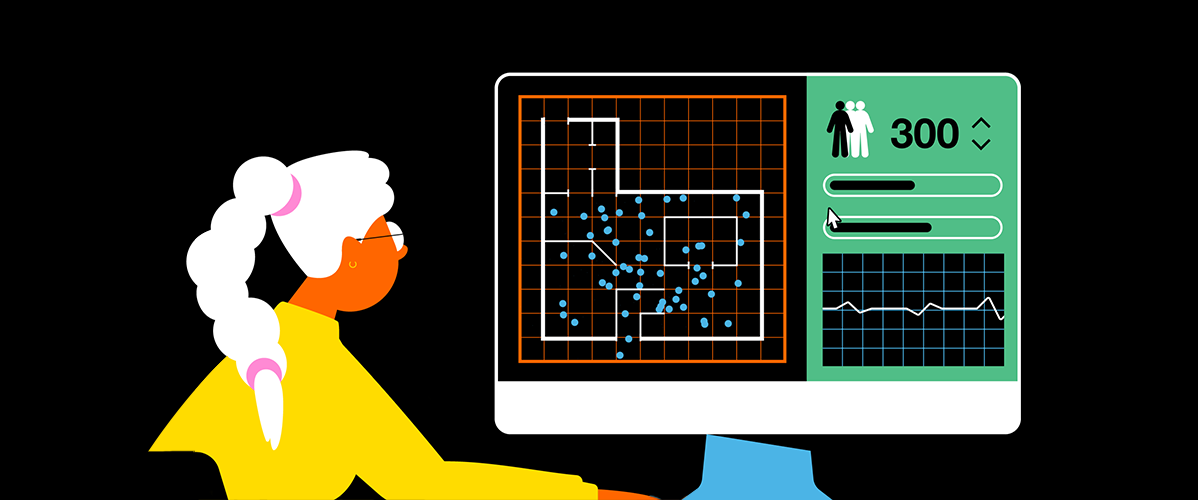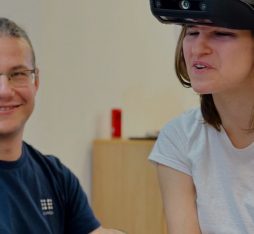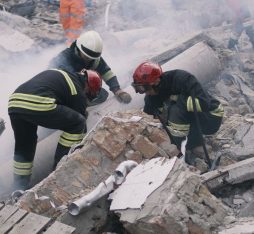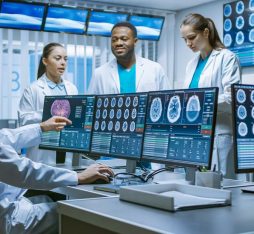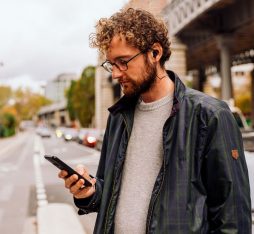“In the COVID-19 context, these technologies are proving particularly useful for facilitating the implementation of physical distancing measures”
The need to limit the number of people in a particular place so as to slow down the spread of COVID-19 has brought people-counting technologies to the fore and, more broadly, those of flow analysis and management. In the post-lockdown context, many museums, shops, businesses, etc. are turning to these technologies to apply physical distancing measures and protect their customers’ and/or employees’ health. But their scope of application is much wider.
People counting to know and to manage people flows
Generally speaking, people counting is performed at the entrance to a building thanks to a device installed on the ceiling, which automatically counts people as they cross a virtual line. The latest generation of counters uses 3D-cameras equipped with computer vision algorithms. Less intrusive – as no picture is taken – connected flooring performs the same function. The solution offered by startup Technis comprises pressure sensors integrated into the flooring combined with artificial intelligence techniques to recognise the events sensed: impact of foot, fall, etc.
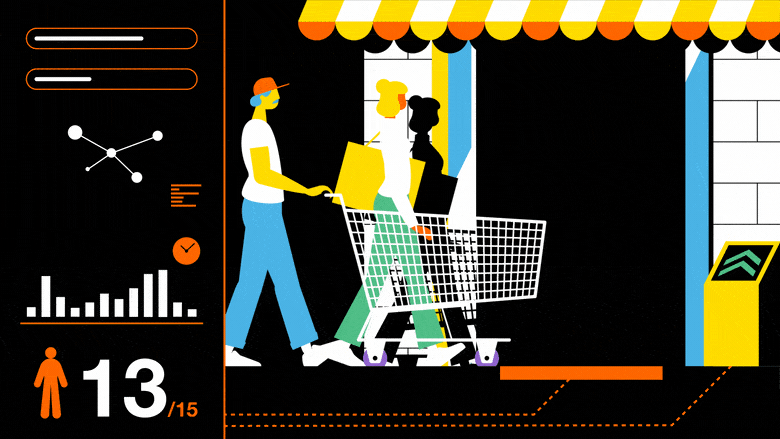 These technologies offer advantages in many areas. In the sales sector, they enable retailers to evaluate the popularity of their store, to determine peak periods and allocate personnel accordingly, and potentially measure the number of visitors converted into buyers as well as the impact of advertising campaigns. Chain store managers can also do comparative analyses, and shopping centres can study traffic to measure the efficiency of each area – which will help them, for example, to set the amount of rent charged – or the congestion of certain aisles.
These technologies offer advantages in many areas. In the sales sector, they enable retailers to evaluate the popularity of their store, to determine peak periods and allocate personnel accordingly, and potentially measure the number of visitors converted into buyers as well as the impact of advertising campaigns. Chain store managers can also do comparative analyses, and shopping centres can study traffic to measure the efficiency of each area – which will help them, for example, to set the amount of rent charged – or the congestion of certain aisles.
Museums and other public institutions, for their part, need to use precise attendance figures to obtain grants and donations, and to comply with safety standards.
People counting is also used as a basis for queue management systems. FoxQMS for example, which is used in Paris Charles de Gaulle airport, provides an estimation in real time of wait times at the various security screening checkpoints.
In the COVID-19 context, these technologies are proving particularly useful for facilitating the implementation of physical distancing measures. Technis has adapted its solution to help public spaces and businesses avoid exceeding the limits of numbers of people. It now includes a digital terminal, placed in front of the building, to show if a path is clear. The limit is configured and adjusted using an application.
People counting is part of the system implemented by Orange to facilitate return to the workplace. The Group, which organises staff presence, for example, by adapting the number of workstations available to the authorised workforce in offices or factories, uses a system of this kind to limit numbers in places such as canteens.
Simulation to guarantee safety and comfort
When taken into consideration right from the design of public spaces or offices (or once the decision has been made to improve them), people flow management can solve several problems: checking the building’s capacity (and its capacity to absorb increases in attendance), guaranteeing rapid evacuation in the event of an incident, and optimising flow sizes to improve comfort in a normal situation. In order to do this, architects and consultants often use crowd simulation software, the workings of which are explained in French journal “Les Cahiers Techniques du Bâtiment”.
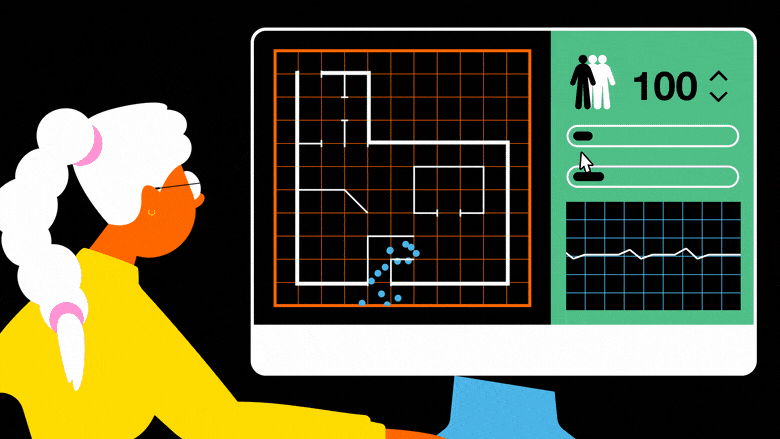 This entails producing a simplified 2D or 3D model of the building, and modelling people’s behaviour – where they come from, where they are going, and at what speed – in a normal situation and in the event of an evacuation. The virtual agents are capable of moving around a complex path and avoiding obstacles. The calculation (for example of a simulation of the evacuation of thousands of people in ten minutes) generates hundreds of trajectories. It is then necessary to align the model with reality. The software includes several default parameters and the user enters those that correspond to the project. The results can then be exploited so as to dimension the building.
This entails producing a simplified 2D or 3D model of the building, and modelling people’s behaviour – where they come from, where they are going, and at what speed – in a normal situation and in the event of an evacuation. The virtual agents are capable of moving around a complex path and avoiding obstacles. The calculation (for example of a simulation of the evacuation of thousands of people in ten minutes) generates hundreds of trajectories. It is then necessary to align the model with reality. The software includes several default parameters and the user enters those that correspond to the project. The results can then be exploited so as to dimension the building.
SimWalk was used, for example, in the Toulouse-Matabiau train station to check if its current layout could handle a significant increase in number of passengers. Thus, 11,240 pedestrians were modelled by group and by type (with or without luggage, persons with reduced mobility, etc.). The results made it possible to identify potential bottlenecks and to suggest improvements.
Biometrics to control access to a building and improve passenger experience
Access control in the workplace is another field of application of people flow management. In addition to traditional technologies (digital codes, badges, QR code readers) we now also have biometrics, which should have the advantage of being more ergonomic and reliable. However, their use is strictly regulated by the CNIL (the French data protection authority), as biometric data is now considered “sensitive” by the GDPR, and must be justified.
Airports are also exploring biometrics in order to reconcile two requirements: reinforcing security and making flow smoother on the ground, that is the set of steps a passenger goes through from their arrival in the terminal through to boarding the plane. The idea is to create a correspondence between a passenger’s facial characteristics and their passport so they may go through all of these steps without presenting travel documents. This is known as “Single Token Travel”.
In 2018, Delta Airlines opened the first biometric terminal in the United States, at Atlanta airport, enabling customers on a direct international flight to use facial recognition technology in Terminal F. After entering their passport information when registering online and scanning their face at a dedicated terminal, they can drop their baggage, pass security control and customs, and board the plane. The same year, Air France tested its “biometric boarding pass”, which consisted in encrypting the biometric data of the passenger’s face into the barcode of their boarding pass. The company had planned to launch an experiment of this type in Paris Orly and Paris Charles de Gaulle airports in March 2020.
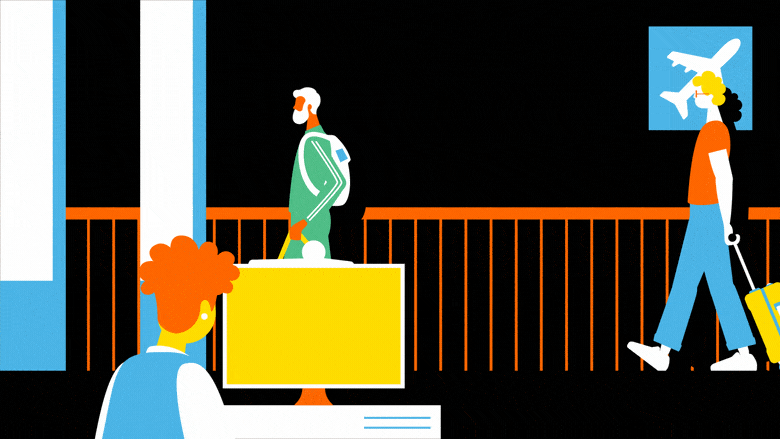 SITA, the Société Internationale de Télécommunication Aéronautique, has been carrying out trials on different biometric devices for several years all over the world. Today they offer the SITA Smart Path, “the most comprehensive whole-journey identity management solution where your face is your boarding pass”.
SITA, the Société Internationale de Télécommunication Aéronautique, has been carrying out trials on different biometric devices for several years all over the world. Today they offer the SITA Smart Path, “the most comprehensive whole-journey identity management solution where your face is your boarding pass”.
People flow management and analysis make it possible to know traffic in real time and to gather a certain amount of useful information. Crucial to the improvement of security and comfort in public spaces, counting or biometric systems must nevertheless be the topic of a genuine reflection on their potential to invade people’s privacy.
How the CNIL defines biometrics: “Biometrics include all automated processes used to recognise an individual by quantifying their physical, physiological or behavioural characteristics. Biometric data are personal data because they allow the identification of a person. For the most part they are unique and permanent (DNA, fingerprints, DNA, etc.).”
Links:
Faciliter le retour sur site en toute sérénité (Facilitating return to the workplace with ease): https://www.orange-business.com/fr/dossier/faciliter-le-retour-sur-site
Cahiers Techniques du Bâtiment article on simulation in people flow management: https://www.cahiers-techniques-batiment.fr/article/flux-de-personnes-comment-organiser-les-circulations.16765
Le contrôle d’accès biométrique sur les lieux de travail (Biometrics access control in the workplace) https://www.cnil.fr/fr/le-controle-dacces-biometrique-sur-les-lieux-de-travail
The world of air transport in 2018: https://www.icao.int/annual-report-2018/Pages/FR/the-world-of-air-transport-in-2018.aspx

